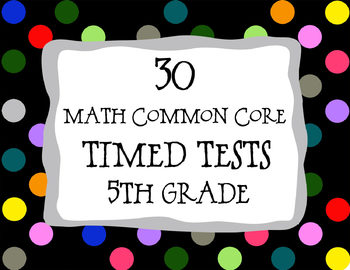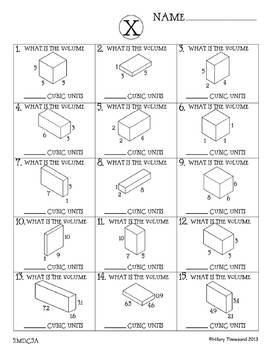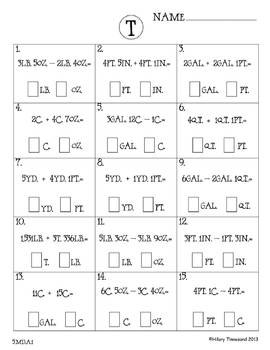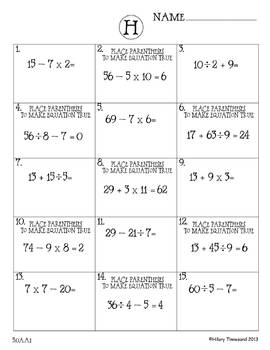30 Common Core ** 5th Grade** Math Timed Tests (assessments or test prep)
Teaching in Walla Walla
1.1k Followers
Grade Levels
5th
Subjects
Resource Type
Standards
CCSS5.MD.A.1
CCSS5.MD.B.2
CCSS5.MD.C.3
CCSS5.MD.C.3a
CCSS5.MD.C.3b
Formats Included
- PDF
Pages
65 pages
Teaching in Walla Walla
1.1k Followers
What educators are saying
This helped my students become more confident about their math skills. They enjoyed using the pages as time tests to see how they improved.
Description
30 Math Timed Test designed specifically to meet the 5th grade Common Core Standards. Use daily for the entire school year. Designed to progress through the Common Core Standards. Quick daily timed tests are also great for homework. Build student confidence and math skills easily as students are self-motivated to progress to the next level. There is so much flexibility with this system you can truly tailor it to fit your needs. You can use as practice, test prep or standards assessment.
Personally I used these as daily timed tests and feel like they contributed greatly to the students understanding of math and confidence. My school is 94% free and reduced lunch, 80% Hispanic and 71% ELL (half my class had not yet passed the state English language proficiency test). On our state test last year our school wide 3rd grade performance in math was a 46% passing rate my class pass 65% in math. I think the timed test and math notebook graphic organizers (in separate listing) were key to our success.
5.NBT.A.1 Expanded and standard form
5.NBT.A.2 Multiplying and dividing by the power of 10
5.NBT.A.3 Read, write and compare decimals to the 1000’s
5.NBT.A.4 Rounding then add / sub decimals
5.NBT.B.5 Multiply multi-digit numbers
5.NBT.B.6 Dividing with remainders
5.NBT.B.7 Add, subtract, multiply, and divide decimals
5.OA.A.1 Using parentheses in expressions
5.OA.A.2 Write numerical expressions
5.OA.B.3 Numerical patterns
5.NF.A.1 Adding and subtracting fractions
5.NF.A.1 Reducing fractions to simplest form
5.NF.A.1 Adding and subtracting fractions w/ unlike denominators
5.NF.A.1 Determine missing addends in fractions
5.NF.B.3 Interpret fractions from visual models
5.NF.B.4 Multiply a fraction by a whole number
5.NF.B.6 Multiplying fractions and mixed numbers
5.NF.B.7 Division with fractions and whole numbers
5.MD.A.1 Conversions of units
5.MD.A.1 Conversions of units with addition and subtraction
5.MD.B.2 Determine line plot data
5.MD.C.3 Find volume of solid figures
5.MD.C.4 Volume measurement by cubic units
5.MD.C.5a Determine cubic volume
5.MD.C.5b Determine volume of irregular shapes
5.G.A.1 Plot coordinates
5.G.A.2 Shifting plot coordinates
5.G.A.3 Understanding 2 dimensional shape attributes
5.G.A.4 Classify 2 dimensional figures
5.G.A.4 Understanding open and closed shapes
* Also includes answer sheets for each test, teacher record sheet, and individual student progress charts.
Personally I used these as daily timed tests and feel like they contributed greatly to the students understanding of math and confidence. My school is 94% free and reduced lunch, 80% Hispanic and 71% ELL (half my class had not yet passed the state English language proficiency test). On our state test last year our school wide 3rd grade performance in math was a 46% passing rate my class pass 65% in math. I think the timed test and math notebook graphic organizers (in separate listing) were key to our success.
5.NBT.A.1 Expanded and standard form
5.NBT.A.2 Multiplying and dividing by the power of 10
5.NBT.A.3 Read, write and compare decimals to the 1000’s
5.NBT.A.4 Rounding then add / sub decimals
5.NBT.B.5 Multiply multi-digit numbers
5.NBT.B.6 Dividing with remainders
5.NBT.B.7 Add, subtract, multiply, and divide decimals
5.OA.A.1 Using parentheses in expressions
5.OA.A.2 Write numerical expressions
5.OA.B.3 Numerical patterns
5.NF.A.1 Adding and subtracting fractions
5.NF.A.1 Reducing fractions to simplest form
5.NF.A.1 Adding and subtracting fractions w/ unlike denominators
5.NF.A.1 Determine missing addends in fractions
5.NF.B.3 Interpret fractions from visual models
5.NF.B.4 Multiply a fraction by a whole number
5.NF.B.6 Multiplying fractions and mixed numbers
5.NF.B.7 Division with fractions and whole numbers
5.MD.A.1 Conversions of units
5.MD.A.1 Conversions of units with addition and subtraction
5.MD.B.2 Determine line plot data
5.MD.C.3 Find volume of solid figures
5.MD.C.4 Volume measurement by cubic units
5.MD.C.5a Determine cubic volume
5.MD.C.5b Determine volume of irregular shapes
5.G.A.1 Plot coordinates
5.G.A.2 Shifting plot coordinates
5.G.A.3 Understanding 2 dimensional shape attributes
5.G.A.4 Classify 2 dimensional figures
5.G.A.4 Understanding open and closed shapes
* Also includes answer sheets for each test, teacher record sheet, and individual student progress charts.
Total Pages
65 pages
Answer Key
N/A
Teaching Duration
N/A
Report this resource to TPT
Reported resources will be reviewed by our team. Report this resource to let us know if this resource violates TPT’s content guidelines.
Standards
to see state-specific standards (only available in the US).
CCSS5.MD.A.1
Convert among different-sized standard measurement units within a given measurement system (e.g., convert 5 cm to 0.05 m), and use these conversions in solving multi-step, real world problems.
CCSS5.MD.B.2
Make a line plot to display a data set of measurements in fractions of a unit (1/2, 1/4, 1/8). Use operations on fractions for this grade to solve problems involving information presented in line plots. For example, given different measurements of liquid in identical beakers, find the amount of liquid each beaker would contain if the total amount in all the beakers were redistributed equally.
CCSS5.MD.C.3
Recognize volume as an attribute of solid figures and understand concepts of volume measurement.
CCSS5.MD.C.3a
A cube with side length 1 unit, called a “unit cube,” is said to have “one cubic unit” of volume, and can be used to measure volume.
CCSS5.MD.C.3b
A solid figure which can be packed without gaps or overlaps using 𝘯 unit cubes is said to have a volume of 𝘯 cubic units.





